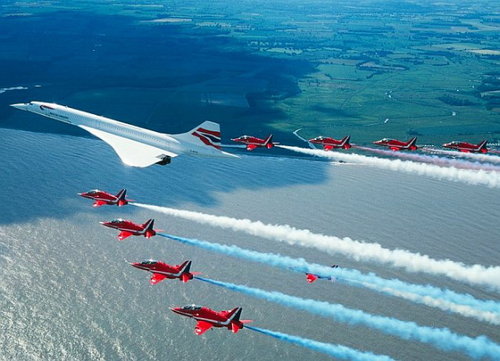 Ten years ago the crash of the Concorde marked the end of the first generation of European cooperation in the Aerospace industry that has lead to numerous military and commercial cooperative projects. The creation of Airbus and their growing domination of the commercial aircraft industry started in the 1970s when BAC from the UK and Aerospatiale from France were linked for the Concorde project via an international treaty governing the creation of the partnership to produce Concorde. Concorde was seen as the next generation in air travel, placing supersonic aircraft ahead of the bigger and slower Jumbo jets to get travellers to their location faster and in luxury. With the fuel crisis in the 1970s and the initial lack of interest in Concorde, the 20 or so Concorde’s were taken on as a luxury service by the national airlines that signed the treaty, British Airways and Air France. The crash of the Air France Concorde near Paris’ Charles de Gaulle Airport in July 2000 raised questions about the aging Concorde’s safety. After an investigation, the rebirth of Concorde took to the skies in July 2001 for test flights with the new safety measures, completing a second test flight from London to New York a few hours before the Sept 11th attacks. In April 2003 Concorde was grounded due to costs and fewer travellers using the exclusive service.
Ten years ago the crash of the Concorde marked the end of the first generation of European cooperation in the Aerospace industry that has lead to numerous military and commercial cooperative projects. The creation of Airbus and their growing domination of the commercial aircraft industry started in the 1970s when BAC from the UK and Aerospatiale from France were linked for the Concorde project via an international treaty governing the creation of the partnership to produce Concorde. Concorde was seen as the next generation in air travel, placing supersonic aircraft ahead of the bigger and slower Jumbo jets to get travellers to their location faster and in luxury. With the fuel crisis in the 1970s and the initial lack of interest in Concorde, the 20 or so Concorde’s were taken on as a luxury service by the national airlines that signed the treaty, British Airways and Air France. The crash of the Air France Concorde near Paris’ Charles de Gaulle Airport in July 2000 raised questions about the aging Concorde’s safety. After an investigation, the rebirth of Concorde took to the skies in July 2001 for test flights with the new safety measures, completing a second test flight from London to New York a few hours before the Sept 11th attacks. In April 2003 Concorde was grounded due to costs and fewer travellers using the exclusive service.
Concorde was a remarkable leap in technology, but was unable to give birth to the next generation of standards in commercial aircraft. The Boeing 747 that came out as well in the 70s was not a direct competitor to Concorde, but was a competitor of a concept of air travel that suited mass movement of passengers and lower the costs of travel in numbers as opposed to a faster and more expensive service. Since that time, the 747s and 737s have been the main aircraft of the commercial airline industry. In the 90s, European cooperation between major aircraft producers in France, Germany, the UK and Spain in the 1970s started to put Airbus in the position to take market dominance away from Boeing. Currently Boeing aircraft are approximately 2/3rd of all commercial aircraft flying today, but Airbus and Boeing sell approximately the same amount and in recent years Airbus has been selling slightly more that Boeing with their A320, A330 and A340 models competing with Boeing’s 737, 767 and 777 models. Airbus has been seeking to dethrone Boeing’s flagship 747 model with their A380 in order to dominate the large airline market, but with delays to the A380 orders and Boeing pushing their 747-8 airliner, it will likely be a 50/50 market split for the Boeing 700’s series and Airbus’ A300’s series aircraft for a long time to come.
It is generally accepted that larger aircraft such as the 747 and A380 will be the main aircraft between larger cities globally, with the 737s and A320s being the connection between hubs and smaller centres. The luxury that was presented on Concorde is now becoming reacquainted on A380s travelling in Asian destinations with regional airlines and larger aircraft such as the 777, 767, 747 and A330/A340 are starting to follow suit. Since 2006, sporadic fuel prices and security issues have made luxury service on more expensive international flights a supplement to higher ticket prices as low cost airlines have used smaller airliners with service cuts to drive down travel costs. Concorde and the theory around a supersonic airline industry cannot be considered a success as the model for the A380 and the manner in which airlines will operate in the future will not follow Concorde. Airbus and European cooperation however does owe a lot to Concorde and Airbus however, and lessons from the late Concorde may just put Airbus on top of the airline industry over the next few years.